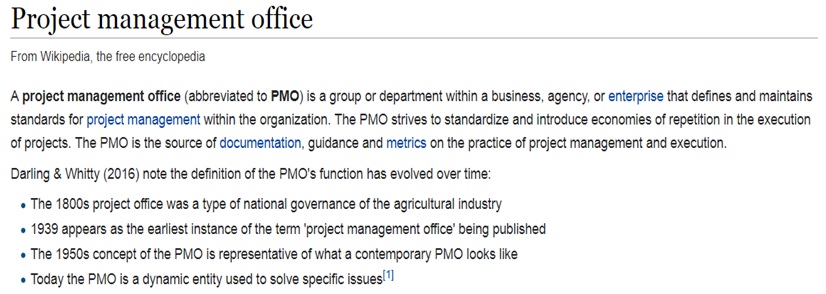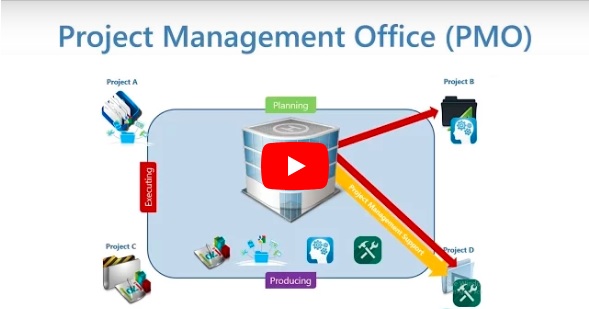The Project Management Office Business Model Dilemma Part 1

Why Think About Program or Project Management Office (PMO) Business Models?
A PMO can be an incredibly productive management execution arm or it can be a bureaucratic time and money suck. PMO’s always start out with good intent, so where do they go wrong? CxO’s listen up, our experience and a decade of research shows it is management largess and lack of follow-up that usually causes PMO usefulness to degrade.
PMO’s have waxed and waned through the years, searching for a working business model. Many have failed and most of the ones that remain are in a constant state of having to justify their existence. However, your PMO can overcome the distraction label and really help your functional units perform better.
There are two main reasons below to ensure your PMO business model is effective.
- Most current PMO Business Models simply do not work and are not sustainable. If your organization is spending time justifying your PMO spend or working escalations from your PMO, you could save valuable executive and mid-management time by removing doubt of value by setting up a better PMO business model.
- To raise performance of your people or their processes. If you have any doubts, have DA&R in to do a quick assessment, info@DataAnalysis.com. We will show you what we have found in every single engagement for the last 20 years, which is that PMO’s have a very spotty reputation for delivering value and yours is likely viewed as being an impediment, rather than adding leverage, to your business units’ performance. Or just jump right to Forming or Reforming your PMO with our help.
There are also many other situations that may be addressed by a PMO reformation below.
- You want to reduce friction between your PMO and functional units.
- You want to increase performance.
- Your PMO does not feel sustainable or permanent.
- Your PMO has to constantly justify its existence.
- Your PMO goals are in direct or indirect conflict with business unit goals.
(This is the reason many PMO’s are disbanded, laid off, or reformed.) - Failures occur more often than expected.
Sustainability is absolutely critical to a long-term PMO and therefore organization success. PMO’s fail when they:
- Bloat by implementing their own “good ideas.”
- Are Directive rather than Advisory.
- Overreach Authority.
- Hire anyone who does not Directly Manage Projects.
First, let’s take a quick look at what a PMO can be. Then in Part 2, coming soon, we’ll walk through “How to Align Your PMO Business Model with Your Business Units.”

Notice the emphasis now on “solve specific issues” rather than as another layer of governance.
If you are considering forming your own, are part of, or interact with a PMO or related program or project management or governance organization, and you feel that your PMO could be a lot more productive, smoother, and add more value, then read on. We will show you how to form and align your PMO business model and address other PMO topics in future posts.
How to Form Your PMO Business Model
PMO’s are usually formed to address a specific problem. Regardless of what that problem is, it is probably a good reason and a PMO is probably a reasonable solution to address it.
Here is the problem with a specific problem solved by a PMO. The PMO is not disbanded when that problem is solved. It must now find other problems to feed on to justify its existence. Like an invasive species brought in to fill a need, it can quickly expand and cause unintended consequences if left unchecked. Here is what we have found is the kiss of death for PMO’s: when they hire a staff person to do Communications. This is indicative of business unit rejection or apathy, either of which will drive your PMO out of business.
The main problem that causes thousands of PMO’s to be disbanded when budget cuts hit, is driving into administrative roles, or being gutted with their PM’s that are redistributed back out to business units because the Executive failed to tell the PMO or Business Units what they must do. The Executives should directly tell their business units what they are to do and that the PMO can help them.
Also, the people who needed to form the PMO in response to a particular problem may well not be the right people to manage your PMO into the future. Parachuting in a Turnaround expert or problem solver into a situation and thinking they will be right to manage day-to-day hassles and problems once things settle down is wishful thinking.
So, to keep from having too much of a good thing, you must tightly charter your PMO to have only specific business problems it can and should address. Here are a few candidate business problems that may be good cause to form or reform your PMO.
- Process and Tools are inconsistent – standardize and provide.
- Provide a pool of shared PM’s (Program or Project Managers) to all.
- Provide a roving team to implement a business change across business units such as an ERP system, M&A integration, Digital Transformation, or other large, complex project that requires a personal touch and collaboration.
- Provide expertise to help, not direct, a business unit to meet compliance or internal standards for their projects. Your PMO should be the solution, not the problem.
Conclusion
Be careful when forming an organization that thinks it should be ongoing to solve a specific problem. Perhaps a temporary, dare I say Project, should be formed to address the problem and disperse when solved.
If you already have a PMO, then don’t worry, you can still salvage productivity. You will just need to reorganize it toward a more effective Business Model.
Most of all do NOT have your PMO be the methodology, compliance, policy, or any other type of police.
Your PMO should be a trusted partner in helping business units reach their goals, not be viewed as impediments or any other sort of hurdle to be overcome.
Contact us to book a PMO Assessment or PMO Formation or Reformation Consulting Engagement
Info@DataAnalysis.com #BusinessGoals #PMO #ProjectManagement #BusinessImprovement #ProcessImprovement #ChangeManagement #Turnaround
What Should Leaders Do to Modify Their PMO’s to be more productive? – Your Thoughts?
Good luck and keep your eye out for ways to drive your PMO forward!
Your path to business success.

